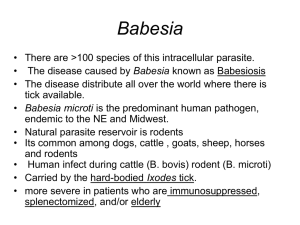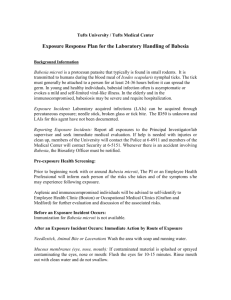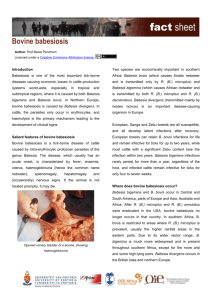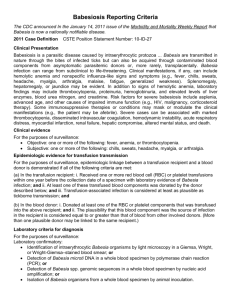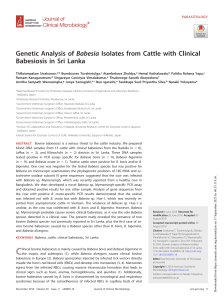THE JOHNS HOPKINS MICROBIOLOGY NEWSLETTER Vol. 24, No. 13
advertisement
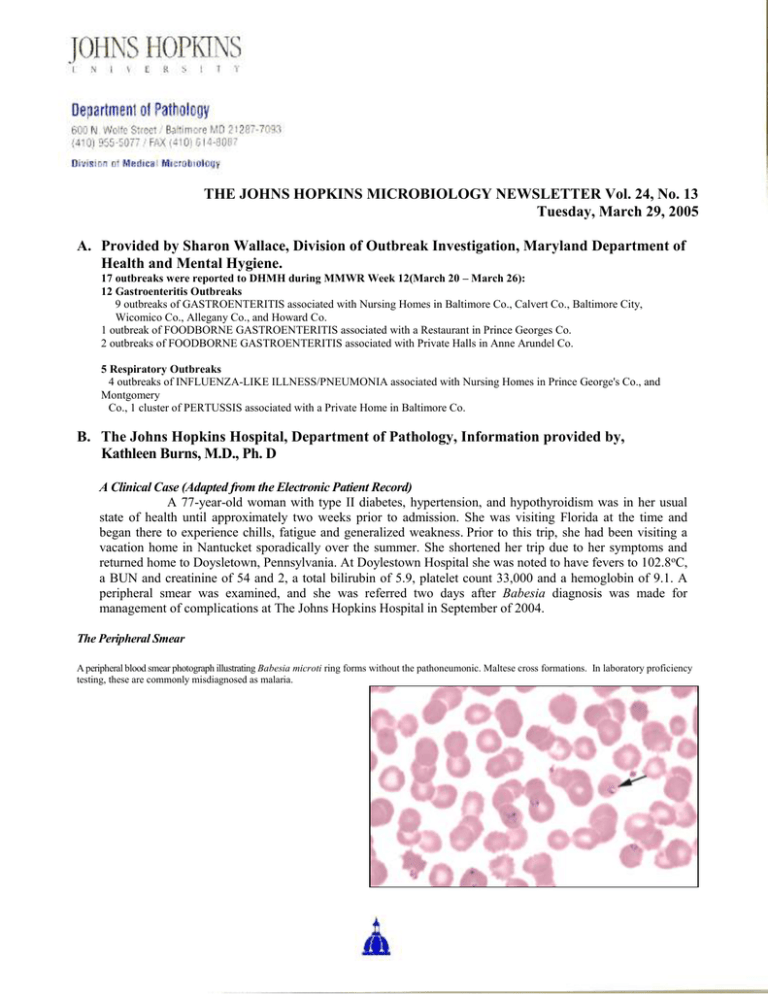
THE JOHNS HOPKINS MICROBIOLOGY NEWSLETTER Vol. 24, No. 13 Tuesday, March 29, 2005 A. Provided by Sharon Wallace, Division of Outbreak Investigation, Maryland Department of Health and Mental Hygiene. 17 outbreaks were reported to DHMH during MMWR Week 12(March 20 – March 26): 12 Gastroenteritis Outbreaks 9 outbreaks of GASTROENTERITIS associated with Nursing Homes in Baltimore Co., Calvert Co., Baltimore City, Wicomico Co., Allegany Co., and Howard Co. 1 outbreak of FOODBORNE GASTROENTERITIS associated with a Restaurant in Prince Georges Co. 2 outbreaks of FOODBORNE GASTROENTERITIS associated with Private Halls in Anne Arundel Co. 5 Respiratory Outbreaks 4 outbreaks of INFLUENZA-LIKE ILLNESS/PNEUMONIA associated with Nursing Homes in Prince George's Co., and Montgomery Co., 1 cluster of PERTUSSIS associated with a Private Home in Baltimore Co. B. The Johns Hopkins Hospital, Department of Pathology, Information provided by, Kathleen Burns, M.D., Ph. D A Clinical Case (Adapted from the Electronic Patient Record) A 77-year-old woman with type II diabetes, hypertension, and hypothyroidism was in her usual state of health until approximately two weeks prior to admission. She was visiting Florida at the time and began there to experience chills, fatigue and generalized weakness. Prior to this trip, she had been visiting a vacation home in Nantucket sporadically over the summer. She shortened her trip due to her symptoms and returned home to Doysletown, Pennsylvania. At Doylestown Hospital she was noted to have fevers to 102.8oC, a BUN and creatinine of 54 and 2, a total bilirubin of 5.9, platelet count 33,000 and a hemoglobin of 9.1. A peripheral smear was examined, and she was referred two days after Babesia diagnosis was made for management of complications at The Johns Hopkins Hospital in September of 2004. The Peripheral Smear A peripheral blood smear photograph illustrating Babesia microti ring forms without the pathoneumonic. Maltese cross formations. In laboratory proficiency testing, these are commonly misdiagnosed as malaria. Babesiosis Babesia parasites, most commonly Babesia microti, are transmitted to humans by bites from the northeastern deer tick Ixodes scapularis (also called Ixodes dammini) or the western United Stated Ixodes pacificus. When symptomatic, sequelae range from mild very vague complaints, to florid parasitemia involving up to 85% of red cells in the immunecompromised. End organ complications include respiratory failure with pulmonary edema and renal failure. Long-term asymptomatic Babesia carrier states have been described in vertebrates, including people. The “intraerythrocytic bacteria”, as they were called, were originally described by Babes in the late 1800s in cattle 1, and the first human infections were described in the 1950s. Babesia sporozoites enter RBCs via the complement C3b receptor after complexing with C3 in the serum 2. The sexual phase of the organism takes place in the tick, while reproduction by asexual formation of merozoites and trophozoites occurs in human RBCs. Like similarly transmitted infections, Babesiosis can be contracted iatrogenically by blood transfusion 3-7. An excellent review of Babesiosis with two case reports is published by Setty et al. 8. In the Eye of the Beholder? Babesia in peripheral smears are sometimes overlooked, and without reliably seeing Maltese cross formations, even a fairly experienced observer can easily mistake it for malaria. It can otherwise be distinguished from Plasmodium species clinically by the absence of travel history outside the United States, and morphologically by pleomorphism of the ring forms or presence of small rings with central palor, lack of hemozoin deposits, and lack of stages other than the ring form. More objective means of detection include PCR-based assays, indirect immunoflourescence assays (IFAs), and enzyme-linked immunosorbent assays (ELISAs), although wide-scale screening applications for currently available tests in populations with low pretest probability (i.e., a blood donor population) seem prohibitively expensive and problematic. A recent study by Homer et al. 9 extrapolate from traditional approaches for identifying assay target antigens, however, and suggest that newly-discovered Babesia antigens might prove useful in identifying low grade symptomatic or asymptomatic carriers. Instead of relying on host antibody targets in advanced infections where many types of killed microbe epitopes may be exposed, their rationale identifies antigens shed from living microbes. Homer et al. infected severe combined immunodeficiency (SCID) mice with Babesia and took only their sera (cleared of cellular debris and intact parasites) for target identification. This sera enriched in shed microbial products was used to elicit an antibody response from immunocompetent mice, whose antisera were collected for a Babesia genomic expression library screen. Several of the putative Babesia gene products identified contain signature sequences of secreted proteins, suggesting that this approach is successful. I imagine the clever principle of this screen may have applicability for diagnostic test development in the setting of many types of infection, and would make interesting reading for the Newsletter audience this week. References; 1. 2. 3. 4. 5. 6. 7. 8. 9. Babes V. Sur l’hemoglobinurie bacterienne boeuf. Comptes Rendus de Acad Sci III 1888;107:692-4. Ward PA, Jack RM. The entry process of Babesia merozoites into red cells. Am J Pathol 1981;102(1):109-13. Wittner M, Rowin KS, Tanowitz HB, et al. Successful chemotherapy of transfusion babesiosis. Ann Intern Med 1982;96(5):601-4. Mintz ED, Anderson JF, Cable RG, Hadler JL. Transfusion-transmitted babesiosis: a case report from a new endemic area. Transfusion 1991;31(4):365-8. Herwaldt BL, Kjemtrup AM, Conrad PA, et al. Transfusion-transmitted babesiosis in Washington State: first reported case caused by a WA1-type parasite. J Infect Dis 1997;175(5):1259-62. Perdrizet GA, Olson NH, Krause PJ, Banever GT, Spielman A, Cable RG. Babesiosis in a renal transplant recipient acquired through blood transfusion. Transplantation 2000;70(1):205-8. Kain KC, Jassoum SB, Fong IW, Hannach B. Transfusion-transmitted babesiosis in Ontario: first reported case in Canada. Cmaj 2001;164(12):1721-3. Setty S, Khalil Z, Schori P, Azar M, Ferrieri P. Babesiosis. Two atypical cases from Minnesota and a review. Am J Clin Pathol 2003;120(4):554-9. Homer MJ, Lodes MJ, Reynolds LD, et al. Identification and characterization of putative secreted antigens from Babesia microti. J Clin Microbiol 2003;41(2):723-9.
